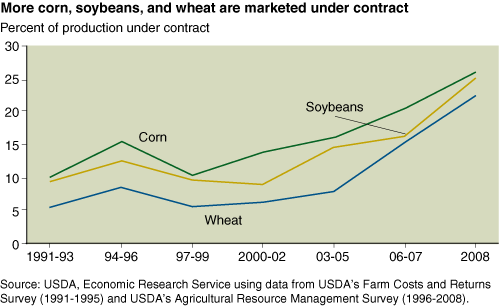Contracting Expands for Field Crops
- by James M. MacDonald
- 3/14/2011
Most U.S. corn, soybean, and wheat production is sold through cash markets, where the producer receives the market price prevailing at the time of sale. However, marketing contracts, which set a market outlet and a pricing arrangement for crops before they are harvested, are becoming increasingly important as risk management tools. Marketing contracts covered 15 percent of corn production in 2001, along with 9 percent of soybean and 6 percent of wheat production. By 2008, contracts covered 26 percent of corn, 25 percent of soybean, and 23 percent of wheat production.
Marketing contracts are particularly important for special higher cost varieties of a commodity, such as high-oil corn or organic soybeans, by providing assurance of a buyer and an acceptable price premium early in the production process. But marketing contracts may also be desirable for some of a farmer's conventional production as an assured outlet and price provide effective risk management.
Contracting farms differ from farms that do not use contracts:
- They are larger--with more acres planted to the specific crop (contracting corn farms harvested 386 acres of corn, on average, compared with 194 acres for oncontracting corn farms) and with greater sales from other commodities as well.
- Crop farmers with contracts use them widely--for example, farms that had any soybean production under contract also put nearly 40 percent of their nonsoybean production under contract, while soybean farms that do not use contracts for soybeans placed only 5 percent of their other production under contract.
- They use other risk management tools as well--relying more on futures and options contracts to hedge risks; they are more likely to invest in onfarm storage, which allows them to better time crop sales; and they are more likely to participate in farmer-owned cooperatives, which may pursue risk management strategies on members' behalf.
Why is more field crop production coming under contract? Looking at corn alone, ethanol production might be considered the main driver of the contracting trend, since ethanol producers buy much of their corn under contract. These firms, however, usually contract with elevators, not with farmers, and the shifts in corn are mirrored by changes in soybeans and wheat.
Price risks play an important role in the expansion of contracting. Prices for all three commodities are high and variable. With greater price risks, more farmers of all sizes are turning to marketing contracts and other risk management tools. But increased price risks can only explain part of the shift to contracts, since contracting for these crops has been expanding since 2001. The continuing shift of production to larger farms likely plays a role because larger farms are far more likely to use contracts and other risk management tools.
This article is drawn from:
- MacDonald, J.M. & Korb, P. (2011). Agricultural Contracting Update: Contracts in 2008. U.S. Department of Agriculture, Economic Research Service. EIB-72.


